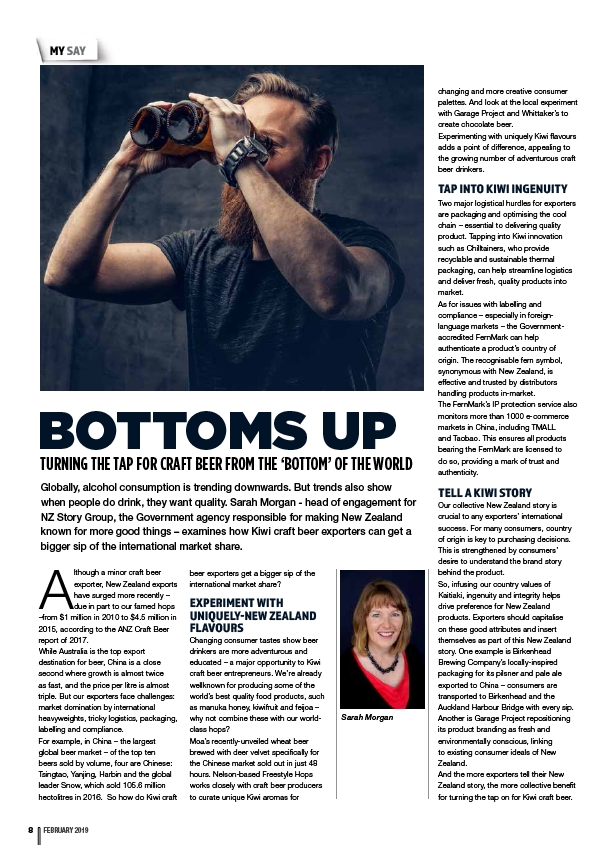
BOTTOMS UP
TURNING THE TAP FOR CRAFT BEER FROM THE ‘BOTTOM’ OF THE WORLD
Globally, alcohol consumption is trending downwards. But trends also show
when people do drink, they want quality. Sarah Morgan - head of engagement for
NZ Story Group, the Government agency responsible for making New Zealand
known for more good things – examines how Kiwi craft beer exporters can get a
bigger sip of the international market share.
Although a minor craft beer
exporter, New Zealand exports
have surged more recently –
due in part to our famed hops
–from $1 million in 2010 to $4.5 million in
2015, according to the ANZ Craft Beer
report of 2017.
While Australia is the top export
destination for beer, China is a close
second where growth is almost twice
as fast, and the price per litre is almost
triple. But our exporters face challenges:
market domination by international
heavyweights, tricky logistics, packaging,
labelling and compliance.
For example, in China – the largest
global beer market – of the top ten
beers sold by volume, four are Chinese:
Tsingtao, Yanjing, Harbin and the global
leader Snow, which sold 105.6 million
hectolitres in 2016. So how do Kiwi craft
beer exporters get a bigger sip of the
international market share?
EXPERIMENT WITH
UNIQUELY-NEW ZEALAND
FLAVOURS
Changing consumer tastes show beer
drinkers are more adventurous and
educated – a major opportunity to Kiwi
craft beer entrepreneurs. We’re already
wellknown for producing some of the
world’s best quality food products, such
as manuka honey, kiwifruit and feijoa –
why not combine these with our worldclass
hops?
Moa’s recently-unveiled wheat beer
brewed with deer velvet specifically for
the Chinese market sold out in just 48
hours. Nelson-based Freestyle Hops
works closely with craft beer producers
to curate unique Kiwi aromas for
changing and more creative consumer
palettes. And look at the local experiment
with Garage Project and Whittaker’s to
create chocolate beer.
Experimenting with uniquely Kiwi flavours
adds a point of difference, appealing to
the growing number of adventurous craft
beer drinkers.
TAP INTO KIWI INGENUITY
Two major logistical hurdles for exporters
are packaging and optimising the cool
chain – essential to delivering quality
product. Tapping into Kiwi innovation
such as Chilltainers, who provide
recyclable and sustainable thermal
packaging, can help streamline logistics
and deliver fresh, quality products into
market.
As for issues with labelling and
compliance – especially in foreignlanguage
markets – the Governmentaccredited
FernMark can help
authenticate a product’s country of
origin. The recognisable fern symbol,
synonymous with New Zealand, is
effective and trusted by distributors
handling products in-market.
The FernMark’s IP protection service also
monitors more than 1000 e-commerce
markets in China, including TMALL
and Taobao. This ensures all products
bearing the FernMark are licensed to
do so, providing a mark of trust and
authenticity.
TELL A KIWI STORY
Our collective New Zealand story is
crucial to any exporters’ international
success. For many consumers, country
of origin is key to purchasing decisions.
This is strengthened by consumers’
desire to understand the brand story
behind the product.
So, infusing our country values of
Kaitiaki, ingenuity and integrity helps
drive preference for New Zealand
products. Exporters should capitalise
on these good attributes and insert
themselves as part of this New Zealand
story. One example is Birkenhead
Brewing Company’s locally-inspired
packaging for its pilsner and pale ale
exported to China – consumers are
transported to Birkenhead and the
Auckland Harbour Bridge with every sip.
Another is Garage Project repositioning
its product branding as fresh and
environmentally conscious, linking
to existing consumer ideals of New
Zealand.
And the more exporters tell their New
Zealand story, the more collective benefit
for turning the tap on for Kiwi craft beer.
Sarah Morgan
MY SAY
8 FEBRUARY 2019